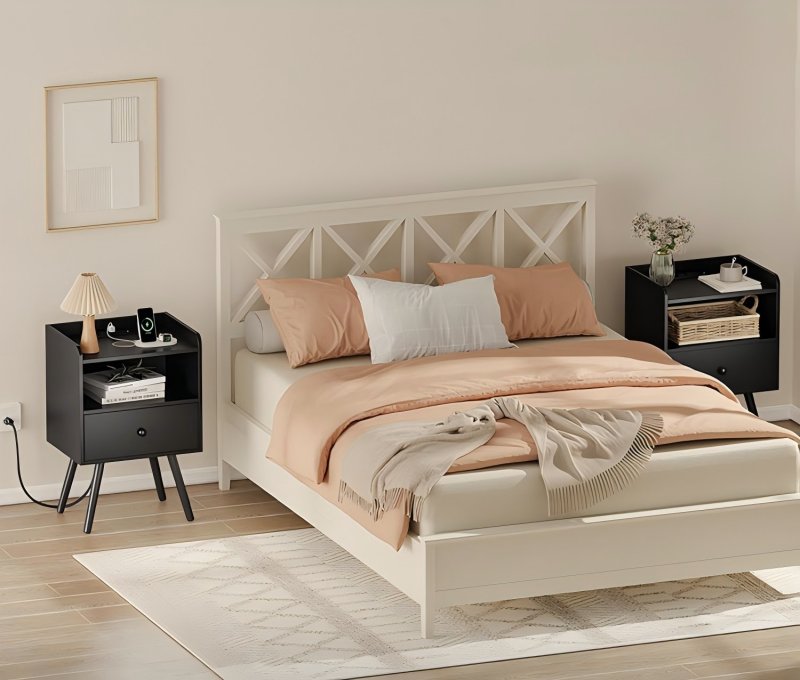Single VS. Double Nightstands Which Is Right for You
The Nightstand is more than just a place for a lamp; it’s an essential bedside companion that provides storage, surface space, and a foundational element for your bedroom’s aesthetic. When selecting nightstands, one of the primary decisions is choosing between a single, unified unit or two separate pieces. This choice impacts the room's functionality, symmetry, and overall design.
Here’s a breakdown of the key considerations to help you determine which option is right for your space.
The Case for a Single (Unified) Nightstand
A single nightstand refers to one larger, continuous piece of furniture that spans the width of your bed, often functioning as a shared surface for both sleepers.
Ideal For:
Beds Against a Wall: If your bed is positioned in a corner or against a wall, a single nightstand on the open side is the most practical and space-efficient solution.
Maximizing Surface Area: It provides one extensive, uninterrupted surface, perfect for larger items like a sound machine, a stack of books, or a decorative tray.
Modern and Minimalist Designs: A low, wide, single nightstand (sometimes called a bedside console) creates a clean, horizontal line that emphasizes a modern, uncluttered look.
Asymmetrical Layouts: For bedrooms with an asymmetrical layout, a single, substantial nightstand can serve as a visual anchor, balancing other furniture on the opposite side of the room.
Considerations:
Shared Space: It requires compromise between partners, as it is a communal surface rather than individualized territory.
Limited Separate Storage: While it may have drawers or shelves, they are shared, which can be less organized than having two separate, dedicated storage units.
The Case for a Double (Matching Pair) Nightstands
This traditional setup involves two separate, matching nightstands placed on either side of the bed.
Ideal For:
Symmetry and Balance: Two nightstands create a classic, symmetrical, and harmonious look that is visually pleasing and makes the bed the clear focal point of the room.
Dedicated Personal Space: Each person gets their own surface, drawer, and storage area. This is ideal for partners with different bedtime routines, reading habits, or charging needs.
Centered Beds: This is the standard and most functional choice for a bed centered on a wall with space on both sides.
Traditional and Transitional Bedrooms: A matching pair is a hallmark of classic bedroom design and works seamlessly in most traditional decor schemes.
Considerations:
Space Requirements: This layout requires adequate space on both sides of the bed—typically at least 24 inches of width per nightstand and enough room to open drawers without hitting the bed.
Cost: Purchasing two high-quality nightstands is often a larger investment than purchasing a single, wider unit.
Key Factors to Guide Your Decision
1. Bedroom Layout and Size:
Large, Symmetrical Room: A pair of double nightstands is almost always the ideal choice.
Small or Asymmetrical Room: A single nightstand on the available side is more practical. You can place a wall-mounted shelf or a very small Table on the other side if needed.
2. Sleeping Partners' Needs:
If you and your partner have vastly different needs (e.g., one needs a large stack of books, the other just a phone), dedicated nightstands provide personalized organization and prevent clutter conflicts.
3. Aesthetic Goals:
For a Formal, Curated Look: Choose a matching pair.
For an Eclectic, Collected Look: You can opt for two different but coordinating nightstands (e.g., same height and color, different styles). This maintains balance while adding visual interest.
For a Bold, Modern Statement: A single, long, low console can make a powerful design statement.
4. Storage Requirements:
Assess what you need to store bedside. If both partners require significant private storage (for medications, journals, glasses), two nightstands with drawers are essential. If storage needs are minimal, a single surface or a pair of smaller tables may suffice.
Conclusion: Which Is Right for You?
Choose a Single Nightstand if your bed is against a wall, you prioritize a modern aesthetic with ample surface area, or your room layout is asymmetrical.
Choose a Double Nightstand Pair if your bed is centered, you value classic symmetry, and you and your partner require dedicated personal space and storage.
There is no universally correct answer. The best choice depends on a thoughtful evaluation of your space, your habits, and your desired bedroom ambiance. By prioritizing both form and function, you can select the nightstand configuration that perfectly supports your routine and enhances your retreat.


